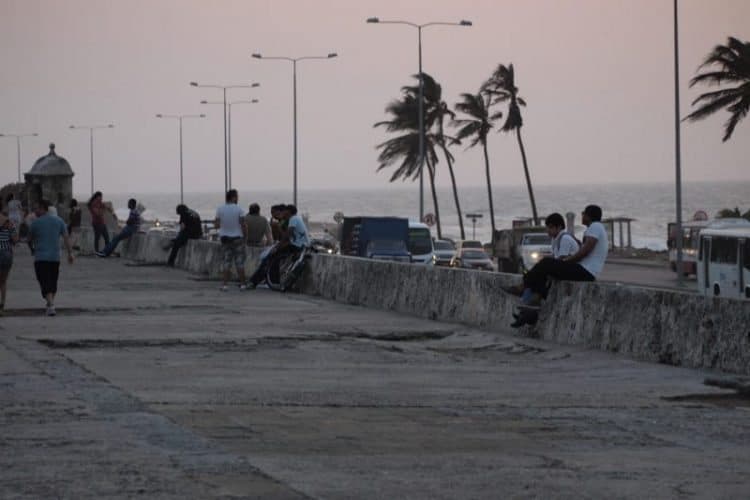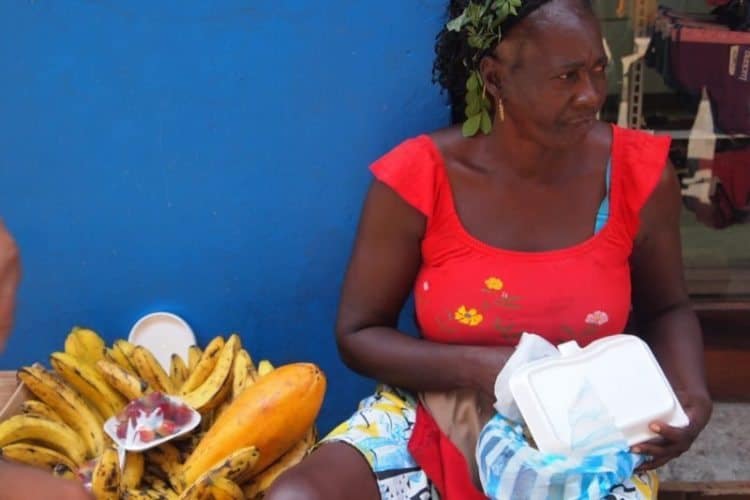
Christmas in Cartagena, Colombia’s Favorite City
By Julian Cleator
It was Christmas Eve as we arrived in the fabled city of Cartagena on the Caribbean coast. My previous impressions of this city were more forged from news reports detailing the exploits of drug cartels in the ’80s and ’90s than of anything connected to a true historical reference.

We arrived at about 8:30 p.m. and caught a taxi for the short ride from the airport into the hotel, located within the walls of the historic old city. Everything seemed to be glowing a warm orange color as Christmas approached.
The taxi drove down narrow, cobbled streets, occasionally getting stuck behind horse-drawn carriages until it pulled up outside of our hotel.
Extremely dark-skinned men, looking for all the life of me just like the actor Yaphet Koto’s portrayal of the villainous Dr. Kanaga in the 1973 James Bond movie, Live And Let Die, rushed to extract our bags from the trunk of the car.
The Mad Hatter
Dressed in white pants with white waist-length capes and topped off with straw hats very similar in design to the one worn by the Mad Hatter in Alice In Wonderland, they looked cartoonishly elegant but tropically menacing at the same time.
The building that housed the hotel was constructed in the seventeenth century and is listed as a UNESCO World Heritage site in itself. Originally built as a convent, it provided the setting for Gabriel Garcia Marquez’s novel Of Love And Other Demons.

Huge stone arches opened up onto an open-air central courtyard where we found ourselves gatecrashing what appeared to be a formal ball, with men in morning suits and gown clad women dining alfresco under the stars.
Christmas is Big in Cartagena
We discovered that Christmas Eve is a big celebration in Latin culture and that dining out at fine restaurants is commonplace.
With the remnants of an airplane dinner sitting nervously in our guts, it was booze we were after and we repaired to the hotel bar where, I kid you not, a swarthy gentleman by the name of Jesus demonstrated an impressive array of bartending skills as Christmas Eve ceded to Christmas morning and everything became gloriously hazy.
For the next three days, we strolled the unbelievably beautiful streets of this colonial sixteenth-century city. Days were spent browsing the shops that never seemed to close and sitting in public spaces talking football with old men, who guffawed riotously when I recalled old Colombian footballers that used to play in the English leagues.

Rounds of $ 2-afternoon beers were bought and instant friends were made. On Christmas Day, after dinner, we wandered down to one of the many plazas and sat on a bench, and watched the locals enjoy the warm evening together.
It was late at night but whole families were out having fun, wrapped up in each other’s company, the atmosphere crackling with the festive spirit.

Children collided with each other and made instant friends, holding balloons and posing with presents in front of spectacularly illuminated Christmas trees.
Old-fashioned ice-cream vendors pushed pram-like carts through the parks and men sold ice-cold beer out of portable coolers on street corners; everyone seemingly in a good mood.
Buddies Asleep
I discovered my afternoon drinking companions soundly asleep, snoring their way through the welcoming yuletide night. It was almost Dickensian in its simplicity but without the biting cold and requisite misery.
It is tempting to write that people were soaking up the atmosphere but as I looked around, I truly believe that it was perhaps just me undertaking that particular pursuit. People were simply getting on with the business of life.

That it happened to be in a spectacular setting, in a tropical climate, late at night in the company of their family and friends; these were merely peripheral adjuncts to the storyline. I was the one drawing the comparisons and marveling at the beauty of it all.
When I thought of the picture that would confront me at home in almost any town, it would be one of silence and shivering cold. The streets would be dead and families would be holed up in their houses, having over-indulged themselves to a degree that verges on the obscene.
More Care-free Cartagena
There really is something to be said for Latin American culture. It appears to be a more carefree and relaxed way of life, where the family is central to everything and commerce seems to play very much a secondary role in the festive season.

In your mind, it’s easy to condemn a host of Latin American countries as third-world backwaters. I think this is partly due to the fact that so many young people leave to seek what we are led to believe is a better way of life in the industrialized north.
More Rewarding Remuneration
However, they might find more rewarding remuneration for their endeavors but it’s hard to see how they could attain a better way of life. A better standard of living in some ways but not, in essence, a better way of life.
Culture stands tall and proud and the family is at the center of it. I sat in an open-air bar one night with a family of four at the next table. The parents were middle-aged and the children were teenagers.
The Mum and Dad went off to dance for a while and upon returning to the table, the mother took her son’s hand and lead him back to the dance floor where they tangoed, limb entwined within limb, for the next few minutes. It seemed like the most natural thing for them to do.

I remember my parents dragging me kicking and screaming to a ballroom dance lesson in a hotel back in the early 80s and I nearly died of embarrassment and self-consciousness.
I think this would be a common reaction for most teenagers having to dance with their parents in the culture that I was brought up in.
Cartagena glistened and shined. Steeped in history, yet firmly up-to-date, and offering everything that both foreigners and locals seek, require and long for.
First-class restaurants and hotels jostle for space with old-time cafes and bars.
Romancing the Stone?

Gem shop proprietors attempt to lure you through their doors with cheesy chat-up lines such as “Do you feel like romancing the stone?”
Ebony gentlemen maneuver through the crowds, their arms laden heavy with jewelry, trying their best to convince you that your tee shirt and shorts ensemble would be best complemented with a string of pearls.
Rotund hawkers offer ‘Cuban’ cigars of dubious provenance and art-shop owners try to tempt you with brightly painted images of burlesque women in compromising poses. Couples stroll along the ramparts of the city, canoodling in the embrasures where cannons once pointed out to sea.
Cartagena’s tourists Respect Local Traditions
Amazing churches offer Christmas masses with signs planted outside offering up pleas to ‘Mr. Tourists’ to respect the occasion, reminding us that religion still has an integral part to play in the proceedings at this time of year.
At the same time, security guards patrol outside every hotel with large and impressive firearms strapped to their hips.
A reminder that it wasn’t so long ago that the cartels ruled the city and that wherever you go in Colombia, there is still a slight underlying current of tension and unease that the past could easily be revisited if it were to be forgotten how far they had come.
Remember your history if you are not to repeat your mistakes.
- Valentine’s Day Suggestions…for that Special Person - January 22, 2026
- Missouri Sports Travel Adventure: From Landmarks to Ballparks - January 21, 2026
- What First-Time Visitors Get Wrong About Visiting Iceland - January 15, 2026








I have never commented on a blog before, but blimey, what colour did you think the locals were going to be? You just can’t help describing them by colour first. The comment you make about the men all looking the same is just unbelievable in this age. You genuinely do not seem to be aware of the lazy racism you are writing. Please drag yourself out of the past.
Couldn’t agree more